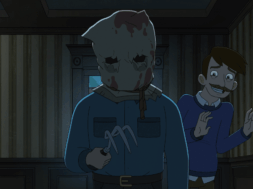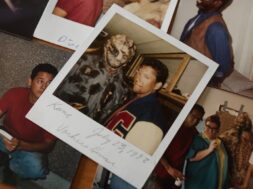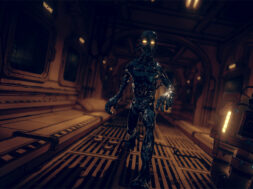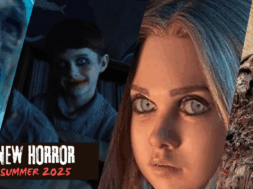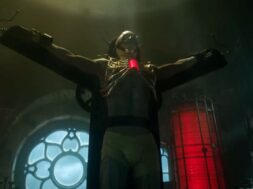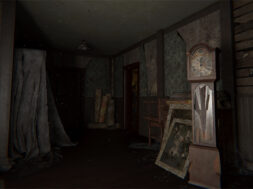We look back on Kenji Eno’s controversial “D Trilogy,” a survival horror series that’s an acquired taste, but one that features some incredible ideas!
It’s not unusual for survival horror video game titles to push the boundaries of the medium and experiment around with the preconceived notions of what the video game experience entails. Horror immerses you in a game’s world in a way that is rare for other titles to achieve and some developers and directors try to get the most out of that gamer vulnerability. This principle may be most present in Kenji Eno’s cult “D Trilogy,” which is a highly problematic, yet fascinating survival horror series.
Kenji Eno, who formed the game studio, WARP, was one of the ‘90s most prolific game developers. He was an ambitious director along the same lines as Hideo Kojima or Suda51. WARP only made eight titles—and only four of them made it Stateside—but the “D Trilogy” stands out as the studio and Eno’s biggest achievement. WARP’s tenure in the video game community may have been brief, but they pushed the boundaries of violence, sexuality, and storytelling in video games. Plus Eno was known for thinking extremely outside of the box, like how one of his games came packaged with a condom and another with a packet of flower seeds. Eno and WARP were not concerned with being conventional.
Eno also very famously made a big fuss when Sony’s inability to meet pre-release request demands for the PlayStation release of D led to Eno permanently burning bridges with the company and shifting allegiance towards Sega. This is the same guy that would hand-deliver a censored version of D over to Panasonic late in production, knowing that when the title gained approval, he would be able to swap the disc out with the uncensored version, which included cannibalism and other taboo topics, just so he could sneak in his edgy material without compromise. This is exactly the renegade that you want making a horror game, it’s just that Eno’s innovation could sometimes go too far.

At its core, D, or D’s Dinner Table, as it’s inexplicably known as in Japan, is a game about trauma, repression, and forgiveness…and Dracula (with one of the most ludicrous designs for the all-mighty vampire yet…who also gets killed by a revolver of all things). The game was originally designed as a prestige title for Panasonic’s 3DO, while it was also ported over to the PlayStation, Sega Saturn, and PC. D was given a hearty publicity push back in the ’90s and gaming magazines were full of advertisements for this allegedly groundbreaking title. It’s this level of fame that led to the whole Sony snafu where the 100,000 pre-orders could not be properly honored (they could only fulfill 40,000) and sales seriously dropped as a result. On the other hand, in Japan the title sold incredibly well on the Saturn and was a clear success for Sega.
Both D and its successor, Enemy Zero, are largely considered to be “unplayable” by certain modern audiences. They fall into the sect of titles from the ’90s that are considered to be more movie than game. D is an FMV-fueled experience that adopts a first person perspective and inserts you into a maze of sorts where cutscenes do most of the heavy lifting. Perhaps the most “innovative” feature about D is that the game plays out in real-time and cannot be paused, which forces the player to work through its two-hour runtime in one go and acquire one of the title’s three endings. In fact, the instruction manual for D even contains the following message from Kenji Eno, where he explicitly refers to this experience as a movie:
“The best way to play this game is from the very beginning to the last
scene. Think of it as if it were an actual movie.
For this reason you have just 2 hours to solve the whole mystery.
Once a movie begins, you cannot stop the movie to get a box of popcorn.
So we did not include a save option.
Please enjoy your movie-going experience.
Please continue to try to solve the mystery of ‘D’ until you are able to
watch the whole movie and discover the best ending.”
Due to the constraints of the game’s environments and the prudent time limit, the story basically sees Laura Harris get transported to a gothic castle in an attempt to rescue her father. She meticulously moves through the building, solves rudimentary puzzles, and braves basic jump scares. All the while, Laura’s father mentally picks away at her and this tortured protagonist remembers more about her horrific past. In the end, you basically learn that both Laura and her father are descendants of Dracula and you’re given the choice to let your father consume you and become the dark prince, or kill him where he stands and return to reality. It’s a bizarre, confusing narrative that isn’t hard to complete and really involves minimal actual gameplay. Apparently some of the game’s downfalls and the confusing narrative has to do with the fact that D was originally conceived with no story until Eno went back in at the end and inserted the character flashbacks to flesh out narrative elements. Furthermore, the game’s excessive violence was also implemented as an afterthought in order to spice up the title and make it stand out more than some typical adventure game.

The game’s opening introduction explains that Lara’s father, a renowned doctor, suddenly loses his mind, murders a bunch of people at his hospital, and holds even more hostage. Lara goes to investigate, but when she enters the hospital she gets transported to a very Resident Evil-style house that’s full of puzzles and apparently a construct of Lara’s father’s mind. This introduction ostensibly provides more story than the entire game, as you’re left to go on a first-person puzzle-solving psychological horror adventure that feels like a early draft of something like Amnesia: The Dark Descent, or at very brief times, Resident Evil 7. The game even features the same psychological scares that play with Laura and the audience’s mind that Eternal Darkness would attempt over a decade later.
D gets heavily derided for its ’90s graphics, its slow movement, and its point-and-click style dungeon crawling gameplay. The game is clearly trying to combine crazes of the time like Myst and the upcoming Resident Evil and it honestly does a good job, even if it’s a highly dated product. The jump scares actually connect, the game’s first person-style effectively creates fear and tension, and it’s a rather unique title for its time. Plus, there’s something just deeply nostalgic about finding ornate keys in fireplaces and working out puzzles that involve numbered drawers or cranks.
D even has a little extra charm since the house that Laura is in appears to be a heavy escape room of dangers. There are literally rooms with spikes on the ceiling that will crash down on you if you’re not careful or giant Indiana Jones-esque rolling boulders that will flatten Laura. It’s an element where death is constantly around the corner that’s reminiscent of the FMV horror titles of the era, but this is a little more sophisticated, even if it does feel like one extended cutscene and isn’t that long of an experience (although it’s three discs long on the PlayStation). On that note, you actually have to finish the game within two hours or you’ll get a game over. Since there’s no save or pause function either, D forces you to work through this puzzle with a ticking clock real-time element that can help to some degree, but mostly irritated gamers. Players were more impressed with the game’s story than the game itself.

D also showed surprising foresight in how it contained rudimentary QTE sequences and multiple good and bad endings, which was not a common feature at the time. The bad ending’s soundtrack is also complimented by the extremely unsettling sound of Laura’s dad sucking her blood for several minutes. Additionally, the game’s end credits are also such a punk rock “fuck you” vanity sequence that contain real photos of the game’s writer and director hard at work, rather than the typical production images, all while a rock guitar blares. This is Kenji Eno.
With D, Eno took heavy inspiration from the Transylvania series of games by Polarware and wanted to tell a bold story that shocked people. Laura experiences traumatic freakouts at times that are very trippy and feel like something out of SE7EN. They chronicle the memory of her mother being stabbed to death and it’s considerably heavy stuff as Laura pieces it all together. They’re very effective and better than they should be. D is a limited game, but it does what it tries to do well. It gets point for being an early example of a truly mature horror game that tried something different, even if it’s not a complete success. At the same time, it also kind of feels like the demo for an engine or something bigger. Arguably P.T. achieves just as much as this does in a much more succinct span.
Ultimately, D works more as a bizarre experiment and relic from a niche period in gaming than something that’s objectively good, but it effectively displays Eno’s weird sensibilities and marks the staples of what Eno carries over in his following two survival horror titles. Eno went so far as saying that this was his real shot at a development career and if D was a failure than he’d be out of the industry. It’s crazy because by today’s standards, D is an incredibly clunky game, but back then, not only did the horror elements get praised, but the graphics and storytelling did, too! It’s even considered to be one of the crown jewels of the 3DO console. D was a clear success from a humble studio that meant that sequels were inevitable. The fact that the title’s PC version has recently been ported over to Steam and GOG.com shows that there’s still some audience for this in modern times, even if its follow-ups, Enemy Zero and D2 are superior titles.
Although the original D was released for the PlayStation, 3DO, PC, and Sega Saturn, this was a franchise that would, in the end, become Sega’s baby, as the following two games in the “D/Laura Trilogy” are on the Saturn and Dreamcast. As stated before, this was done in retaliation to Sony as they didn’t print enough copies of D to meet pre-orders and failed consumer demand, but Eno was even more vindictive about D’s sequel. In fact, the franchise’s transition from Sony to Sega was made public in the most badass way possible. At the 1996 PlayStation Expo, during the unveiling presentation for Enemy Zero, the PlayStation logo brazenly morphed into the logo for the Sega Saturn.
The follow-up title, Enemy Zero, maintains a very similar structure to its predecessor, but it refines and perfects the model. Enemy Zero ultimately feels like a hybrid of Alien and System Shock, or what a scaled down version of Alien: Isolation or Dead Space might have looked like if they were made in the ‘90s. For a game that came out in 1997, Enemy Zero also looks fucking gorgeous. It’s still a game full of FMV sequences, but the graphics impress and the game’s introduction is so cinematic and substantial it’s relegated to its own disc (the game is four in total). D may conjure some scares from its visuals, but Enemy Zero excels in that respect and then also gets creative, like with how it recreates the ventilation shaft sequence from Alien (complete with blinking beacon sound effect, which is your only indicator of how close a monster is to you). Enemy Zero builds its horror out of a genuine fear over what’s chasing you. In fact, much of the game pulls from Alien, right down to the fact that Laura is now on a space station that’s headed back to Earth when an extraterrestrial gets on board and starts culling the crew members (some of which even turn out to be androids). It’s a premise that’s already a lot more engaging and action-heavy than what was present in D.

Enemy Zero’s biggest claim to fame is its extremely unconventional gameplay. It follows D’s first-person FMV-approach, but then also allows other styles of first-person exploration. However, the biggest thing here is the game’s combat system, because the foes in Enemy Zero are freaking invisible. You’re left to rely on an underdeveloped, rudimentary sound system to figure out just how far away your invisible threats are from you. Furthermore, your weapon requires charging before it fires and if you charge it for too long, it won’t work, which just means that timing becomes even more crucial. The broken, needlessly difficult nature of the game’s combat is to intentionally make players avoid an offensive approach. You’re supposed to be cautious and on the lookout of danger and the game finds a creative way to express that. It’s a brilliant experience the first time around, but it becomes more frustrating than frightening as the game goes on. You’ll either get the invisible monster hunting controls, or you won’t, and that will largely impact your enjoyment of this game.
It’s also admirable to see how much the game tries to do with sound and how important it is for survival (Eno was a musician in his own right and would also go on to make a game for the blind that’s entirely sound with no visuals at all, so clearly the area was important to him). One segment in particular towards the end of the game involves the disembodied voice of your lover who directs you through a maze and tells you where to go, which is also a pretty revolutionary navigation system for the time. On top of this, there’s also a finite amount of times that you can save in the game (around 21) and this rigid save system also effectively ratchets up the survival horror aspect of the experience, even if it is more of a psychological worry than something that will actually be a problem in the game.

The issue with Enemy Zero is that as impressive and atmospheric as it is, it still largely feels like an interactive movie or extended cutscene more than a game itself. Eno once again refers to the title as an “interactive movie” in the manual and goes so far as to christen “Laura” as the first “digital actress” who would appear in multiple video games acting in different roles. It’s an incredibly adventurous idea that didn’t come pass. When given the opportunity to expand and contextualize both Laura and Enemy Zero, Eno goes about it in incredibly obtuse terms within the game’s manual:
“One of the conceptual subjects of the work will be ‘Digital Sadness’ multimedia, as digital media, has ephemeral factors and risks. Through showing Enemy Zero, I would like to make it clear that there are such contingency risks in the digital world of the modern times.”
This nonsense is simultaneously both a terrible and perfect introduction for Enemy Zero and the scope of Eno’s work. In spite of its limitations, Enemy Zero still tries to rise above and do something with the technology of the time. Curious misfires like this game surely allowed for future survival horror classics to be possible in some respects. The actual corridor and hunting segments, as suspenseful as they are, are also pretty hokey and silly looking. The idea of invisible monsters is somewhat novel, but you can’t help but feel like it’s just trying to justify hardware limitations. Enemy Zero is still a deeply repetitive experience, but one that’s not without its many charms.

Even though the game’s galactic setting mostly sticks to Alien’s plot beats, the final act features some ridiculous plot twists that ramp up the tension in ludicrous ways. Both D and Enemy Zero deal with repressed or lost memories and the dangerous nature of recovering those memories, but Enemy Zero also tries to grapple with a fairly complex story about what it means to be human and to have feelings.
In order to make Enemy Zero as big of a spectacle as he imagined it to be, Eno sought out Michael Nyman of Gattaca and The Piano fame to do the game’s score, whereas Eno did the music himself for D. Eno never dreamed that getting Nyman would be possible, but he painstakingly convinced him to take the job. Furthermore, not to outdo Eno’s previous rock star efforts, 20 limited edition copies of the title were available for around 2000 dollars. These games would be hand-delivered by Eno himself and they hold a Guinness World Records Gamer’s Edition record for “Most Exclusive Special Edition.” In spite of all of this pomp, the game was critically panned and largely a failure in the West, even if it did find a bizarre following in Japan. Curiously, most critics enjoyed the aesthetics that are established at the start of the game, but as the title goes on the ridiculous plot and characters continue to taint that experience. However, those that can get around the combative controls can find a deep, quirky gem in this.
D2 is arguably the weirdest game in Eno’s exceptionally strange trilogy and only takes the series to more insane places. This is a title where during one boss fight a giant pigeon will swoop in to momentarily eat your enemy’s entrails. There’s also lots of validation for tentacle porn fetishists in this game and it really earns its MA rating, so proceed with the proper amount of caution.
D2 was originally planned to take the series back to its roots at Panasonic for their new M2 console, the cancelled follow-up to the 3DO. D2 drastically changed when it headed over to the Dreamcast (although a trailer for the original game for the M2 version was still shown at 1997’s Tokyo Game Show and can be found hidden away in the Japanese release of D2). Eno also continued his streak with weird marketing in order to publicize the game, like when he simply held a celebration for the arrival of the cherry blossom rather than feature any game demos.
There are echoes of both of Eno’s first two games in this title (Kimberly from Enemy Zero even sticks around), even though this game once again tells a totally new story with a new version of Laura. If Enemy Zero is Kenji Eno riffing on the Alien franchise, then D2 is his tribute to The Thing and fellow body horror classics.

The game’s opening cinematic (which is even more of a production than the one for Enemy Zero) perfectly sets the scene for the game and establishes its trippy tone, but the similarities with the snow-laden environment, isolated cabin locale, and otherworldy visitor are rather blatant. It also features a surprising act of air-based terrorism that’s startlingly real and would be impossible to put in a video game today. This plane crash is the accident that kicks off Laura’s journey this time around. Laura and Kimberly need to locate a missing young girl and figure out the mystery of the monsters that populate the mountain-set region.
Each title in this trilogy practically doubles in length, and D2 is the longest, fullest experience (it’s five Dreamcast GD-ROMs) in the trilogy. Although D2 still sticks to the series’ FMV first-person roots, it finally moves the game into third-person territory. Then it adds to that formula with RPG elements and a full 3D world at your disposal, too. You can even hunt hare and caribou for meat, which feels like an extremely modern element to the title. You’re also able to take photos of the gorgeous locales with your camera to save and trade through your VMU memory cards later, for no other reason than enjoyment and adventure.
Perhaps the game that feels closest to something like D2 is the other overlooked title, Parasite Eve. D2 is definitely the greatest evolution of this franchise and it’s just a shame that another game couldn’t come along to further refine the formula in an even more modern survival horror setting. It’d have been incredible to see what Kenji Eno could have done with a VR game if he hadn’t passed away in 2013.

D2 presents an extremely human story, like something you’d see in The Last Of Us. There are moments like when Laura and Kimberly just listen to a recording of a song that she wrote and characters just get to connect and be human, rather than dialogue worrying about story or plot. Feels like the kind of ambitious experiments that the Dreamcast was known for. The title also deals with repressed memories, like the previous games, but also explores the theme of free will from Enemy Zero in regards to whether we still have agency after being infected and what price is put on those people’s lives.
D2 also truly feels like an open world game in regards to how Laura is lost in the wilderness and just has a whole lot of terrain to explore while she tries to orient herself. On that note, there are some truly beautifully rendered environments. The demolished airplane that you visit is a wonderfully detailed landscape. In general, the title’s animation and voice acting re also pretty impressive for early Dreamcast-era title and Eno continues to push his hardware to the limit.
Enemy Zero hides its monsters, but D2 shoves them right in the audience’s face and doesn’t hold back. They’re all hideous, tentacle-laden beasts that look like they’re hybrids of Carpenter, Cronenberg, and William Birkin’s lab. They also allow the game to begin with a fight sequence and mini-boss battle, which is already more exciting than how both of the previous two games begin and highlights the more action-heavy approach in this game. To that end, D2 contains an interesting battle system where you can’t move, but rather only look and aim, which is buggy, but works well enough here. The ferocity and frequency around the encounter rates of enemies is a little high, but it helps increase the tension and these attacks actually come as surprises, which puts you in Laura’s shoes. Even simple monsters also just look gnarly.
The game truly knows how to make things creepy and disturbing, whether it’s with how people “blossom” into these monsters, weird character affectations, or the abundance of body horror. All of the infected humans’ banter is also seriously upsetting. The game makes a strong impression and gets under your skin more than some survival horror titles might.

As D2 goes on, more elements of the occult, mysticism, Stonehenge, and the apocalypse come into play to make matters even more complicated. The game’s antagonists want to resurrect “The Shadow” and create a new perfect society in his image. The game’s final act puts genetic engineering and cloning under its microscope and gets considerably more insane with some bonkers reveals in the end. That being said, the origin of the monster that’s loose in the game is actually solid and relates to the attempts to clone a wooly mammoth and what happens when they find something else. The idea that Laura is actually the combination of this monster DNA, human DNA, and divine coincidence, makes her a Messianic-like figure that needs to merge with this ultimate darkness to save the world from Armageddon. So pretty normal stuff.
The enemies in the game extend from beyond just monsters to include clone dopplegangers, too. There’s a boss fight against a violin-playing angel. There’s also a boss that’s basically a mix between SHODAN and Mother Brain. D2’s final foe is some sort of interdimensional cluster of tumors and eyes. This fight actually employs a creative strategy where the boss blinds you and then takes your hearing and D2 reflects this by your video and audio disappearing in the final stages of the battle! It’s not exactly well executed, but it’s an impressive idea.
In the tradition of the other games, Laura’s super trippy fantasy sequences are incredible and real mind splitters. It’s like Lynch or Hideaki Anno put these together as images of dinosaurs are spliced over eclipses and destruction as the game attempts to overload your brain. At the same time, it juxtaposes real footage of war, death, pestilence, and genocide over Laura’s visions to culminate in a deeply unsettling sequence.

D2’s ending cinematic is as ambitious as the one that opens the game and is really the big thing to talk about with this title. In the 15-minute movie, Laura time travels back to the final moments of New Year’s Eve, 1999—perhaps an alternate reality of it—to ensure that the universe stays on the right path. It’s here that she meets her eternal protector, David. After Laura succeeds in protecting the world, a vanity reel plays out that not only shows all the good that she’s done, but it goes all the way back to the time of the dinosaurs and cavemen. It proceeds to cover World War II, the moon landing, the destruction of the Berlin Wall, and all of history, only the world is still full of problems and Laura’s been inconsequential to these epidemics. It’s one of the most pretentious endings of all time for a video game. It’s so self-important and it doesn’t even feel earned after such a muddled narrative.
All of this is then followed by an unnecessary description of planet Earth and some data that the world’s population was 6 billion in 1999 and that the population has grown by about 78 million people since 1998. It then jumps to predicted data that the Earth’s population in 2100 will be around 10.4 billion people. Has this actually been a game about protecting Earth’s resources and the dangers of overpopulation? It certainly never feels like it and even if it were, how could Laura stop such a thing? Then the on-screen text goes on to give HIV virus statistics and how quickly the disease has spread in a few decades. It culminates with the news that around 2.5 million people died from AIDS in 1998 and that even more people have died from starvation, are illiterate, or without electricity. It shows percentages about how the Earth’s atmosphere is deteriorating and animals are dying.
As grim numbers flash across the screen, it’s hard not to get bummed out, but what’s the point of all of this? To motivate gamers to make a difference? That’s a noble message, but it’s one that’s barely present in the game itself. It’d be like if at the end of The Exorcist or Halloween there was a bunch of statistics on how many people get raped and how many animals get tested on every year. It’s just pretentious disconnect. Furthermore, if it wants to make a point about self-preservation it could have done it in a much subtler, more organic style than this lengthy, preachy info dump. It’s such an unexpected note to conclude on and it taints the entire experience to the point that it makes the gamer forget what they’ve just finished playing.

D2 was, unfortunately, a critical and commercial failure and it didn’t even experience a European release. It’s ambition and high production quality was praised, but it still saw a very mixed reception. The game was also boycotted by feminist groups due to its imagery and blatant tentacle rape, even if the game does feature a strong female role model in the end. Kenji Eno’s involvement in the video game industry post-D2 is minimal (although You, Me, and the Cubes is a larf), but it’s still a major accomplishment that he was able to release this weird trilogy on his own terms, even if it didn’t set the world on fire. Each title in the “D Trilogy” is a trailblazer in its own way.
This is also the only series of survival horror games where your child companion melts into a pile of green goo just when you think everything’s okay.
D is both available on GOG.com and Steam


